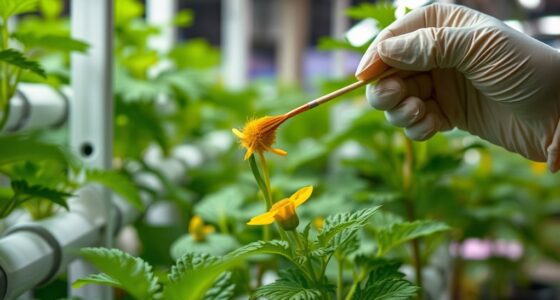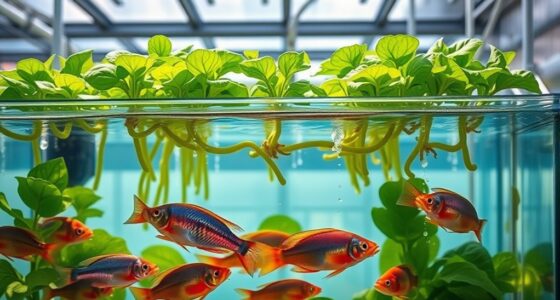Organic hydroponics means growing plants without soil while strictly using natural, certified organic inputs. It emphasizes organic-approved fertilizers, compost teas, and natural amendments to keep the system chemical-free. Water must be clean and free from synthetic chemicals, often requiring careful filtering. This method delivers fresh, chemical-free crops with higher yields and sustainability benefits. To understand how organic standards fit into soilless growing and guarantee your produce remains truly organic, explore further details below.
Key Takeaways
- Organic hydroponics uses natural, approved inputs like compost teas and plant extracts, without synthetic fertilizers or chemicals.
- Certification focuses on input quality and process compliance, ensuring the produce remains chemical-free and environmentally sustainable.
- Water used must be free from synthetic contaminants, often filtered or sourced from rainwater or well water meeting organic standards.
- The method promotes sustainable practices, higher yields, and faster growth while maintaining organic integrity in a soilless system.
- Success relies on careful input selection, adherence to certification standards, and fostering natural microbial activity in the growing environment.

Have you ever wondered if it’s possible to grow healthy, organic produce without soil? It might sound like a contradiction, but with organic hydroponics, it’s entirely feasible. This method allows you to cultivate fruits, vegetables, and herbs in a soilless setup while still adhering to organic principles. The key lies in understanding what “organic” truly means in this context and how it applies to hydroponic systems, which traditionally rely on nutrient solutions instead of soil.
Growing organic produce without soil is possible through hydroponics when using natural, certified inputs.
In conventional farming, organic certification emphasizes soil health, biodiversity, and natural inputs. However, in soilless systems, the focus shifts toward the purity of inputs and the environmental sustainability of the setup. When you grow organically in a hydroponic system, you need to guarantee that every component—water, nutrients, growing medium—aligns with organic standards. This means using organic-approved fertilizers, compost teas, or natural amendments instead of synthetic chemicals. The growing medium, often coconut coir, perlite, or other inert materials, must also be free of synthetic additives.
One common misconception is that hydroponic systems can’t be organic because they lack soil, which is often seen as the foundation of organic farming. But organic hydroponics emphasizes the quality of inputs rather than the presence of soil itself. You’re nurturing plants with naturally derived nutrients, promoting microbial activity, and fostering a balanced, sustainable environment. For example, instead of chemical fertilizers, you might use compost teas, fish emulsions, or plant-based extracts to supply essential nutrients.
Another crucial aspect is maintaining the integrity of the water source. Water must be free from contaminants and ideally be filtered or treated to ensure it’s clean and pure. Some growers opt for rainwater or well water, provided it meets organic standards. Regular monitoring ensures that no synthetic chemicals seep into your system, preserving the organic nature of your produce.
The benefits of organic hydroponics are significant. You can produce clean, chemical-free crops year-round, often with higher yields and faster growth rates than traditional soil-based organic farming. Plus, it uses less water and space, making it a sustainable choice for urban environments or areas with poor soil quality. Additionally, using certified organic inputs ensures compliance with standards and enhances consumer trust.
Ultimately, growing organically without soil requires careful attention to input sources, maintaining natural processes, and adhering to certification standards. When done correctly, it’s a powerful way to enjoy fresh, nutritious, and truly organic produce, all while leveraging the advantages of soilless cultivation.
Frequently Asked Questions
Can Organic Hydroponics Be Certified as Organic Globally?
Yes, organic hydroponics can be certified globally, but it depends on the certification standards of each country. You’ll need to meet specific guidelines that include using organic-approved nutrients and growing practices. Keep in mind, some regions are more flexible than others. To get certified, you should work with recognized certifying bodies and verify your methods align with their organic standards, regardless of where you operate.
What Are the Best Organic Nutrient Sources for Hydroponic Systems?
Like a chef selecting fresh ingredients, you should choose nutrient sources that are natural and sustainably farmed. For hydroponic systems, organic options include fish emulsion, seaweed extract, compost teas, and bone or blood meal. These sources release nutrients gradually, supporting healthy plant growth. Always prioritize organic certifications, and remember to adapt your feeding schedule to guarantee your plants thrive without synthetic chemicals.
How Does Organic Hydroponics Impact Plant Taste and Nutritional Value?
Organic hydroponics enhances your plants’ taste and nutritional value by providing natural, nutrient-rich solutions that promote healthy growth. You’ll notice more vibrant flavors and increased levels of vitamins and antioxidants compared to conventional methods. By using organic inputs, you encourage better nutrient absorption, which leads to tastier produce with higher nutritional content. This approach not only benefits your plants but also supports a healthier, more sustainable growing system.
Are Organic Hydroponic Methods More Sustainable Than Conventional?
Yes, organic hydroponic methods are generally more sustainable than conventional ones. You reduce soil degradation by avoiding synthetic chemicals, and you often use recycled water, which minimizes waste. Plus, organic practices promote healthier ecosystems and less pollution. By choosing organic hydroponics, you help conserve resources and support environmentally friendly farming. It’s a smarter, greener way to grow your food while maintaining high quality and nutritional value.
What Challenges Do Organic Hydroponic Growers Typically Face?
You face challenges like maintaining strict organic standards while managing pests and diseases without synthetic chemicals. Balancing nutrient levels in a soilless system can be tricky, and sourcing certified organic inputs often proves costly. Weather fluctuations and water quality issues add unpredictability, pushing you to innovate constantly. Despite these hurdles, your dedication to sustainability drives you to develop resilient, eco-friendly methods that push the boundaries of organic hydroponic farming.
Conclusion
So, next time you boast about your organic hydroponics setup, remember—without soil, “organic” might just be a label more than a reality. It’s amusing how we cling to the idea of purity when so much of it depends on how we define “organic.” Maybe, in the end, the real lesson is that even in soilless growing, the concept of authenticity is more about perception than substance. Ironically, it’s all about what you choose to believe.










